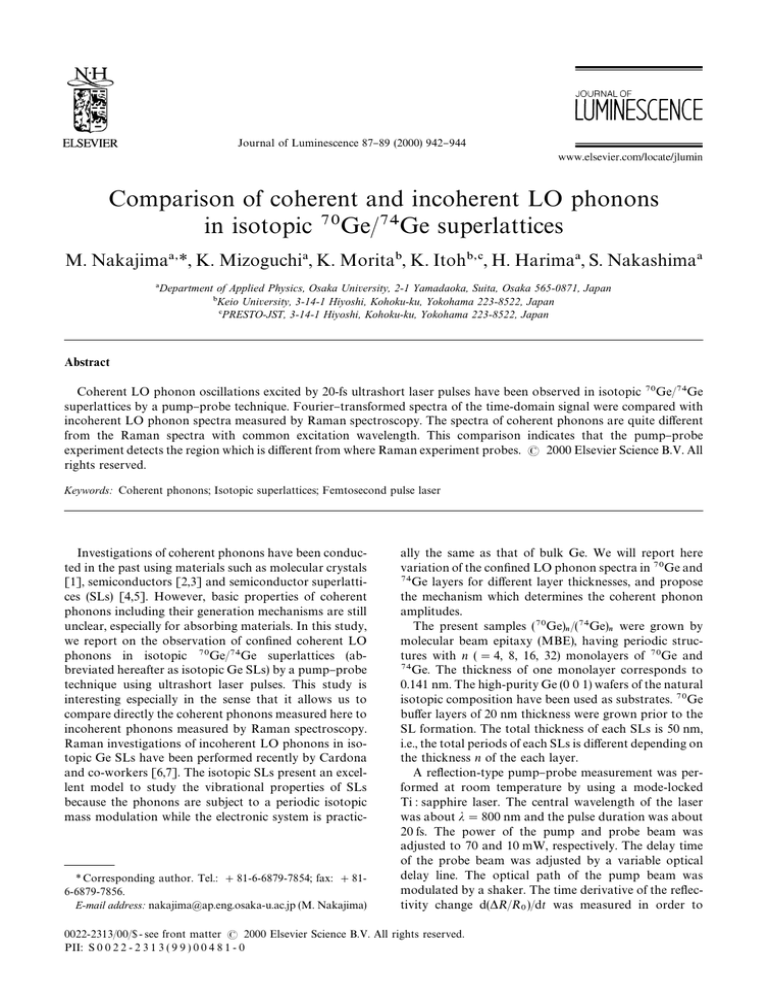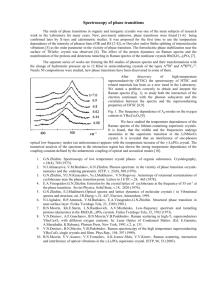
Journal of Luminescence 87}89 (2000) 942}944
Comparison of coherent and incoherent LO phonons
in isotopic Ge/Ge superlattices
M. Nakajima *, K. Mizoguchi , K. Morita, K. Itoh, H. Harima , S. Nakashima
Department of Applied Physics, Osaka University, 2-1 Yamadaoka, Suita, Osaka 565-0871, Japan
Keio University, 3-14-1 Hiyoshi, Kohoku-ku, Yokohama 223-8522, Japan
PRESTO-JST, 3-14-1 Hiyoshi, Kohoku-ku, Yokohama 223-8522, Japan
Abstract
Coherent LO phonon oscillations excited by 20-fs ultrashort laser pulses have been observed in isotopic Ge/Ge
superlattices by a pump}probe technique. Fourier}transformed spectra of the time-domain signal were compared with
incoherent LO phonon spectra measured by Raman spectroscopy. The spectra of coherent phonons are quite di!erent
from the Raman spectra with common excitation wavelength. This comparison indicates that the pump}probe
experiment detects the region which is di!erent from where Raman experiment probes. 2000 Elsevier Science B.V. All
rights reserved.
Keywords: Coherent phonons; Isotopic superlattices; Femtosecond pulse laser
Investigations of coherent phonons have been conducted in the past using materials such as molecular crystals
[1], semiconductors [2,3] and semiconductor superlattices (SLs) [4,5]. However, basic properties of coherent
phonons including their generation mechanisms are still
unclear, especially for absorbing materials. In this study,
we report on the observation of con"ned coherent LO
phonons in isotopic Ge/Ge superlattices (abbreviated hereafter as isotopic Ge SLs) by a pump}probe
technique using ultrashort laser pulses. This study is
interesting especially in the sense that it allows us to
compare directly the coherent phonons measured here to
incoherent phonons measured by Raman spectroscopy.
Raman investigations of incoherent LO phonons in isotopic Ge SLs have been performed recently by Cardona
and co-workers [6,7]. The isotopic SLs present an excellent model to study the vibrational properties of SLs
because the phonons are subject to a periodic isotopic
mass modulation while the electronic system is practic-
* Corresponding author. Tel.: #81-6-6879-7854; fax: #816-6879-7856.
E-mail address: nakajima@ap.eng.osaka-u.ac.jp (M. Nakajima)
ally the same as that of bulk Ge. We will report here
variation of the con"ned LO phonon spectra in Ge and
Ge layers for di!erent layer thicknesses, and propose
the mechanism which determines the coherent phonon
amplitudes.
The present samples (Ge)L /(Ge)L were grown by
molecular beam epitaxy (MBE), having periodic structures with n ("4, 8, 16, 32) monolayers of Ge and
Ge. The thickness of one monolayer corresponds to
0.141 nm. The high-purity Ge (0 0 1) wafers of the natural
isotopic composition have been used as substrates. Ge
bu!er layers of 20 nm thickness were grown prior to the
SL formation. The total thickness of each SLs is 50 nm,
i.e., the total periods of each SLs is di!erent depending on
the thickness n of the each layer.
A re#ection-type pump}probe measurement was performed at room temperature by using a mode-locked
Ti : sapphire laser. The central wavelength of the laser
was about j"800 nm and the pulse duration was about
20 fs. The power of the pump and probe beam was
adjusted to 70 and 10 mW, respectively. The delay time
of the probe beam was adjusted by a variable optical
delay line. The optical path of the pump beam was
modulated by a shaker. The time derivative of the re#ectivity change d(*R/R )/dt was measured in order to
0022-2313/00/$ - see front matter 2000 Elsevier Science B.V. All rights reserved.
PII: S 0 0 2 2 - 2 3 1 3 ( 9 9 ) 0 0 4 8 1 - 0
M. Nakajima et al. / Journal of Luminescence 87}89 (2000) 942}944
Fig. 1. Oscillatory component of the time-domain signals of
isotopic (Ge) /(Ge) SLs for various SL layer thicknesses at
L
L
room temperature.
obtain only the oscillatory component. The Raman scattering measurement was carried out at room temperature
and at 10 K in a quasi-back-scattering geometry by using
an Ar-ion laser at 488 and 514.5 nm, and a cw Ti : sapphire laser at 800 nm.
Fig. 1 shows time derivatives of the re#ectivity change
d(*R/R )/dt in the isotopic Ge SLs with di!erent periodic structures. The beatings observed indicate that multiple phonon modes are excited in all four samples. To
analyze the time-domain signals and compare with the
Raman spectra, we have obtained Fourier transform
(FT) spectra of the time-domain signals as depicted in
Fig. 2(a). The vertical broken lines stand for frequencies
of LO phonon modes in bulk Ge (9.16 THz) and Ge
(8.94 THz) [8,9]. The frequencies for n"32 are in agreement with those for the bulk modes. A peak for bulk
Ge due to the bu!er layer appears clearly for the n"4
sample. The arrows denote con"ned LO phonon modes
in Ge and Ge layers, as observed previously by
Raman scattering [6]. As n increases, the intensity of the
con"ned mode in Ge layers is enhanced as compared
with that in Ge layers, and the con"ned mode in Ge
layers shifts to higher frequency. Higher-order con"ned
LO phonons from Ge layers as marked by asterisks,
denoted here as LOK (Ge) with m being the order, are
observed in the spectra for n"16 and 32 between Ge
and Ge con"ned LO phonon modes [6]. Raman
spectra observed for j"488 nm are shown in Fig. 2(b)
for comparison. The Raman spectra are almost the same
as the FT spectra in Fig. 2(a) in the sense that the
frequency and intensity ratio of the con"ned LO modes
are extremely similar to each other.
In order to see the frequency variation of the con"ned
LO phonons in more detail, the peaks in the FT spectra
943
Fig. 2. (a) Fourier transform spectra of time-domain signals in
Fig. 1. (b) Raman spectra of isotopic Ge SLs excited at 488 nm at
room temperature. The vertical broken lines indicate the frequencies of LO phonon mode in bulk Ge and Ge.
Fig. 3. The solid and broken lines denote calculations for LO
K
frequencies (m"odd) in Ge and Ge layers, respectively.
Observed peak frequencies are shown by "lled circles against n,
the number of monolayers in (Ge) /(Ge) SLs.
L
L
were decomposed into multiple Lorentzian components,
and the constituent peak frequencies were compared with
a calculation based on a linear chain model [10] using
appropriate frequencies and masses for the Ge isotopes
[8,9]. In Fig. 3, the LO phonon frequencies are plotted
against n by "lled circles. The solid and broken lines
denote calculations for LOK (m"odd) in Ge and Ge
layers, respectively. Although pronounced anticrossings
between di!erent branches of optical modes occur at
around n"12, 20, and 30 [6], this e!ect is not included
in our calculation. The con"ned LO branches with even
m are omitted here because a Raman intensity calculation based on the linear chain model combined with the
bond polarizability model shows that their contribution
can be well neglected. The calculation shows that at
n"16, for example, the three con"ned mode frequencies
observed agree fairly well with those for LO , LO (for
944
M. Nakajima et al. / Journal of Luminescence 87}89 (2000) 942}944
Fig. 4. Raman spectra of isotopic Ge SLs at ¹"10 K excited
with (a) 514.5 nm and (b) 800 nm. The broken lines indicate the
frequencies of LO phonon mode in bulk Ge and Ge. The
dotted line shows for frequencies of LO phonon mode in bulk
Ge substrate.
Ge, with arrow) and LO (for Ge). The calculation
also shows that at n"32 the modes at 9.03 and 9.13 THz
(with arrows) correspond to LO and LO for Ge,
respectively.
Spitzer et al. [6] observed Raman spectra of isotopic
Ge SLs, and compared the result with the calculation
based on the planar bond-charge model and the bond
polarizability approach. They have found that the optic
phonon modes in isotopic Ge SLs are con"ned in the two
di!erent constituent layers. Since the Raman intensity
depends on the atomic displacements, the resemblance of
Raman and FT spectra indicates that coherent phonons
are also con"ned in Ge or Ge layers of the isotopic
SLs, and that the amplitude of the coherent phonon is
governed by the displacement of atoms in a constituent
layer.
The FT spectra with j"800 nm are similar to the
Raman spectra with j"488 nm as described above, although the di!erence in the laser penetration depth d into
Ge is large between j"800 and 488 nm [11]. In order to
clarify the dependence of spectra on d, Raman measurements were performed at 10 K by using two di!erent
excitation wavelengths j"514.5 and 800 nm as shown
in Fig. 4(a) and (b). The con"ned LO phonon modes
appear clearly for j"514.5 nm, while for j"800 nm
the spectra are dominated by the signals from the Ge
substrate (9.13 THz) and the Ge bu!er layer
(9.28 THz). This is explained by the di!erence of penetration depth: They are estimated as d"200 and 17 nm for
j"800 and 514.5 nm, respectively [11]. Thus, the
Raman scattering with j"800 nm probes both the SLs
and the substrate, while that with j"514.5 nm mainly
probes the SLs. Surprisingly, the series of spectra of
coherent phonons taken with j"800 nm (Fig. 2(a)) is
similar to those of Raman spectra taken with a much
shorter wavelength j"514.5 nm (Fig. 4(a)). This means
that the pump}probe experiment with j"800 nm is
sensitive to the region close to the surface only. Since the
generation of the coherent phonons in Ge will require
excitation of high density of carriers, the region where the
coherent phonons are generated is restricted to the outer
surface region. In order to understand why the
pump}probe experiment is sensitive to the region close to
the surface only, it is desirable to compare the coherent
phonons in superlattices with various thicknesses.
In summary, we have observed coherent con"ned
LO phonon oscillations in isotopic Ge SLs by the
pump}probe technique at excitation wavelength of
800 nm. The Fourier-transformed spectra of the oscillations were compared directly with Raman spectra
recorded at various excitation wavelengths. The Fouriertransformed spectra are found to be very similar to the
Raman data taken with a shallow penetration depth of
laser, i.e., the observed pump}probe signals derives from
the near-surface region only. We clari"ed that the amplitude of the con"ned coherent LO modes is dominated by
the atomic displacement of Ge atoms in the constituent
layers.
References
[1] Y.-X. Tan, E.B. Gamble, K.A. Nelson, J. Chem. Phys. 83
(1985) 5391.
[2] T. Pfeifer, T. Dekorsy, W. KuK tt, H. Kurz, Appl. Phys. A 55
(1992) 482.
[3] W.A. KuK tt, W. Albrecht, H. Kurz, IEEE J. Quantum
Electron. 28 (1992) 2434.
[4] K. Mizoguchi, K. Matsutani, M. Hase, S. Nakashima, M.
Nakayama, Physica B 249}251 (1998) 887.
[5] A. Bartels, T. Dekorsy, H. Kurz, K. KoK hler, Phys. Rev.
Lett. 82 (1999) 1044.
[6] J. Spitzer, T. Ruf, M. Cardona, W. Dondl, R. Schoner, G.
Abstreiter, E.E. Haller, Phys. Rev. Lett. 72 (1994) 1565.
[7] H.D. Fuchs, P. Molinàs-Mata, M. Cardona, Superlattices
Microstruct. 13 (1993) 12661.
[8] H.D. Fuchs, C.H. Grein, C. Thomsen, M. Cardona, W.L.
Hansen, E.E. Haller, K. Itoh, Phys. Rev. B 43 (1991) 4835.
[9] H.D. Fuchs, C.H. Grein, M. Cardona, W.L. Hansen, K.
Itoh, E.E. Haller, Solid State Commun. 82 (1992) 225.
[10] B. Jusserand, M. Cardona, in: M. Cardona, G. GuK ntherodt
(Eds.), Light Scattering in Solids V, Springer, Berlin, 1989,
pp. 49}152.
[11] R.F. Potter, in: E.D. Palik (Ed.), Handbook of Optical
Constants of Solids, Academic Press, New York, 1985,
p. 465.





